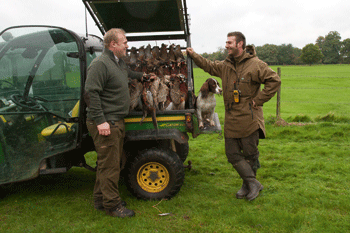Kimpton Hoo Farm shoot

Game shoots fall into a number of categories: they can be commercial, and employ full-time keepers and sell days on the open market; there are the DIY shoots, where a group of willing helpers all chip in with various duties ranging from feeding to pest control; and then there are what we call in our part of the country “farmers’ shoots”, where a few local farmers pool their land and set up small shoots for themselves and a few friends. Kimpton Hoo Farm is such a shoot, but be under no illusions that it is in any way haphazard just because it is run on a part-time basis by a couple of farming friends. Far from it: it is as well-run as any commercial shoot, and has a thoroughly congenial atmosphere.
Kimpton Hoo is situated near Welwyn in Hertfordshire, and is run by Jake Harding. The part-time keeper, Ollie Bertie, has been helping out for the past three seasons and he has a small band of helpers who assist with dogging-in the pheasants, fox control and the building and maintenance of the two pheasant pens. They release around 1,400 pheasants and approximately 200 red-legged partridges and shoot six days a season. The average bag is 130, though on a good day they have achieved up to 175. The 2012 season was one of the best on record, with a return of 56 per cent. Ollie put this down to the fact that the gamecover on nearly all shoots was very poor so the birds tended to stay on home ground rather than wander off.
The farm extends to nearly 1,200 acres but the shooting is concentrated on about 400 acres towards the centre. The ground is made up of grassland with some arable and numerous blocks of woodland, in which most of the later season shooting takes place once the leaves have dropped from the trees. There are some areas that are under the Entry Level Stewardship scheme and the farm has a number of 6m headlands, which help to create natural wildlife corridors through the agricultural land.
The shoot is run in conjunction with the neighbouring farm, which also runs a small gamefarm business and supplies the pheasants and partridges. Jake plants about 10 acres of covercrops, which are mainly maize with some smaller blocks of artichokes. They plan to plant more perennial cover over the next few years.
Redleg before wicket
With eight main drives and three or four smaller ones available, there is plenty of variation for the Guns, who are mainly made up of farming friends and neighbours. The shoot also has a number of unique features: the main one is the cricket pavilion and pitch that sit in the middle of one of the drives. Jake explained that the pitch is owned by the farm and leased to a local cricket club. Fortunately, the shooting and cricket seasons are at different times of the year.
The weather wasn’t good for the farm’s first day’s shooting: it was raining hard with a brisk wind and the mud was clinging on to our boots as we set off for the fi rst drive. The Guns lined out on a recently drilled field and it was immediately obvious that the topography of the farm lent itself to showing some good, testing birds. Almost as soon as the beaters started cracking their flags, a couple of coveys of redlegs were whisked away on the wind and pegs one and two had a chance to warm their barrels.
The stiff breeze did prove rather problematic but Jake and Ollie made some adjustments and managed to persuade a few long-tailed pheasants to head in the right direction. Although it was the first day’s shooting for many Guns, a dozen found their way on to the gamecart. As Jake set out the Guns on the next drive, I saw an impressive old tree standing at the edge of the flushing point. It turned out to be a cedar of Lebanon, which Jake thinks could well be over 200 years old. As the drive got under way, I wondered how many shoots the old tree had seen and what stories it could tell.
After the Thrift Wood drive, which took place in front of the cricket pavilion, everyone enjoyed a welcome lunch of home-produced beef sausages and soup. Jake decided to add in a couple of extra drives as the birds had not been entirely co-operative so far.
As the weather cleared and the sun shone it became obvious that, despite this being a “farmers’ shoot”, they could still show some very high birds that would test even the most experienced Gun. The atmosphere throughout the day had been very jovial, and, as we walked back to the gamecart, Jake told me that it is important to him that everyone who comes to Kimpton Hoo goes away with a smile on their face.
Exclusive picking-up team
The picking-up team is exclusively female and is headed by Avis Boreham of Ashleygrove Gundogs. Avis has been training gundogs for many years and most of the ladies have been to her for training. Jake also kindly lets her bring novice handlers to the shoot to gain experience for their dogs.
There are normally six handlers with a collection of Labradors, cockers and a couple of golden retrievers. They were well-organised and the sweeping-up after each drive was done quickly and efficiently. They certainly contributed to the final bag of 139 head.








